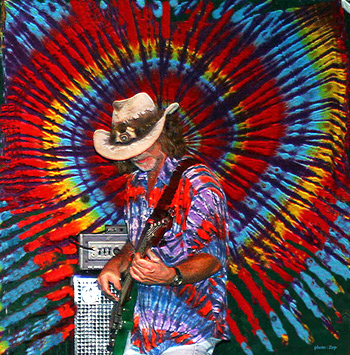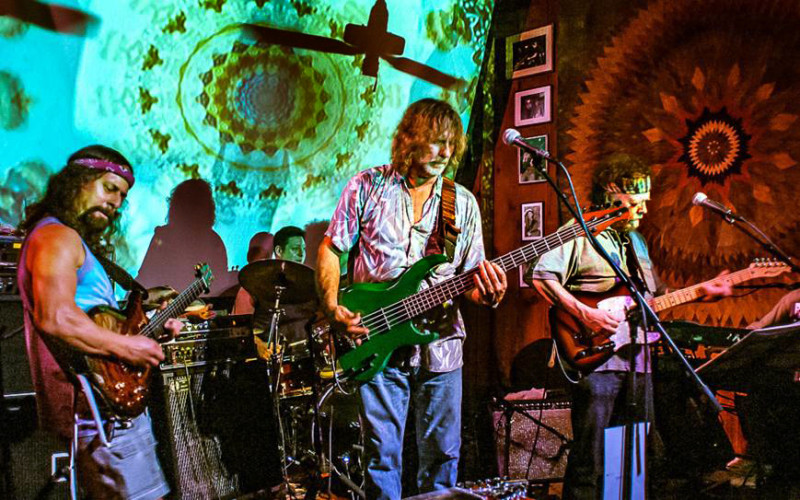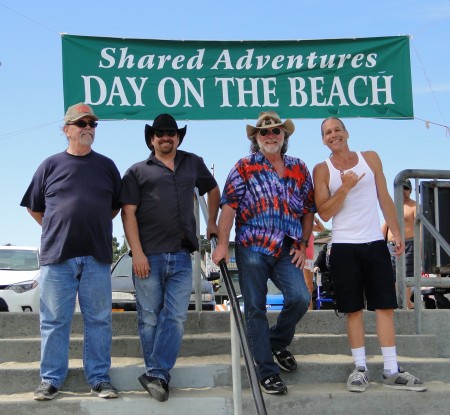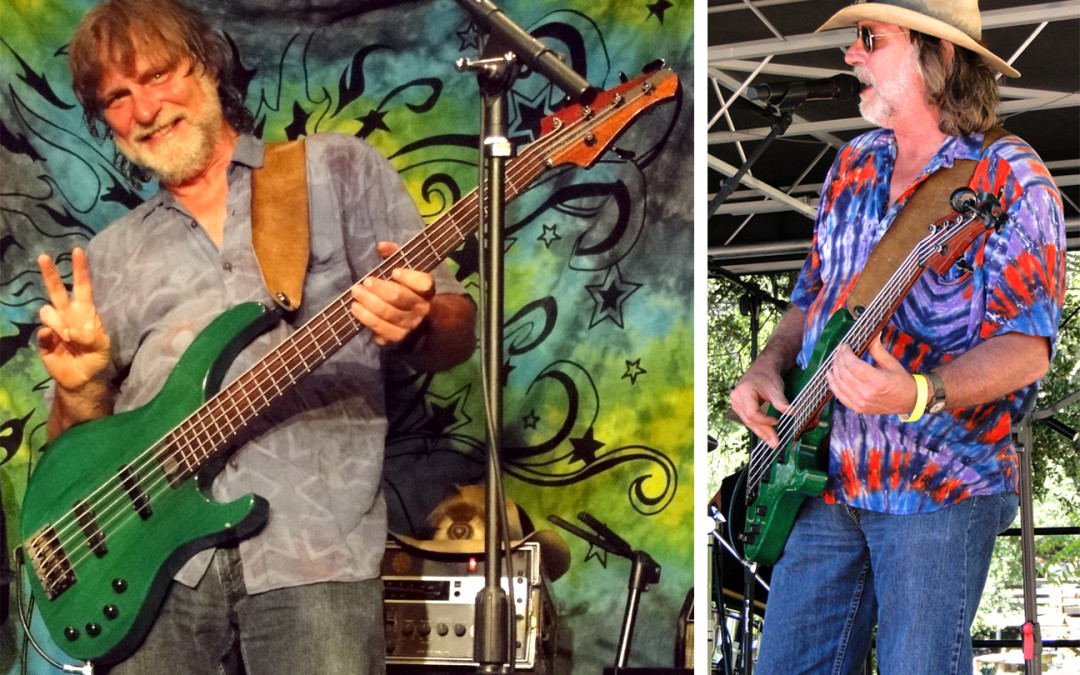© Cathie Porter photos
Rock ‘n’ roll survivor Bill Laymon played bass guitar for dozens of bands − and still does!
“Gimme Five, I’m Still Alive!”
********
Bass Player is Rock ‘n’ Roll Survivor

Bill Laymon Photo by Zep Turtle
Bill Laymon is a long-time resident of the Bay Area in and around Santa Cruz, Calif. I had the good fortune to meet him for a Sunday brunch with Cathie Porter and my sister, Linda Oliver, during a recent visit to SC, and was taken by how open and willing he is to talk about his extensive career playing bass in dozens of rock bands, and as a studio musician. When Bill agreed to an interview with Ragazine, it seemed only right the conversation should take place with another musician. Eric Ross, blues guitarist, master of the theremin, singular performer and long-time friend of Ragazine was glad to oblige.
— Mike Foldes
*** ***
With Eric Ross Contributing Music Editor
RAGAZINE: How did you get started in music?
BILL LAYMON: Hi, Eric. Very nice to meet you and greetings from Santa Cruz, California. I’m delighted to do this bit for Ragazine. I come from a fairly musical household outside Springfield, Illinois. My father loved Big Band swing music and my mother was a madrigal singer in college. I’m the youngest of four boys, so I grew up with a deep background in the rock ‘n’ roll of the ’50s and ’60s: Elvis, Beach Boys, Beatles, Simon & Garfunkel, Dylan, etcetera. All of my brothers were musical and my brother Bob had the first psychedelic rock band in Central Illinois, and I thought that was so cool. My first band was called “Blue Fever,” in 1968; our main gig was playing a street party in some kid’s parents’ driveway. Neighbors called the cops on us! I should have taken that as “rock ‘n’ roll 101” course. I was hooked.

Bill Laymon, center, with his brass guitar. Photo by Bob Minkin
Q: What attracted you to the bass guitar?
BL: As I said, my father was a Big Band generation kid and he was a bass player in swing bands; he loved that music and actually got to play with Tommy Dorsey a little bit in the ’30s. He always tried to share his passion for that music with his boys, and would always point out the bass to me, make me pay attention to its critical role in those complex arrangements. Plus, my brother played bass in that psychedelic rock band and I thought he was so completely hip. Back in the ’60s there was so much great popular music everywhere; American culture & the world was changing dramatically. Anyway, a lot of the song tracks you’d hear on the radio back then was really great stuff and the bass playing on those records I found to be spectacular, appealing. Turns out that the bass lines on a lot of those tracks was the legendary LA studio bassist Carol Kaye − along with her group of session players, who were casually referred to as “The Wrecking Crew.” They played for seemingly everybody back then. These kinds of things attracted me to the bass guitar when I was a kid; plus I shared a bedroom with my brother and he had one kicking around in there. I started fiddling around with it. One of the first things I figured out for myself on bass was that rolling, bolero bass line on “White Rabbit” by Jefferson Airplane, which was a seminal song then (and still is). That came in useful for me later.
Q: What or who were your biggest influences?
BL: On bass guitar, my biggest influence is certainly Carol Kaye. I pretty much learned to play the thing from her series of instructional books − I’m basically self-taught from those books. Many years later, after I’d graduated from University of Illinois and done the jazz band program there, I moved directly here to Santa Cruz, California, full of far-flung fantasies of playing with the New Riders of the Purple Sage. Shortly after arriving here, I saw a small mention in the local paper that Carol Kaye was giving bass lessons at this music store downtown. I couldn’t believe it! I went down to that store and waited till she came out of one of the instruction rooms. I was kind of afraid to approach her and slipped her a note asking if she might consider giving me lessons. Well, she called me the next day. Turns out she was taking a break from the Hollywood scene and flying under the radar in Santa Cruz. We set up a series of lessons − not so much how to play the bass, but how did she invent all those bass lines? I learned a lot from Carol and she is my dear friend to this day. She’s fantastic, a wonderful person. OK, that’s Carol. Other big influences on me have been Paul McCartney, Phil Lesh, Jack Casady, Barry Oakley, Rick Danko, Tiran Porter, Dave Torbert, Kenny Gradney, Peter Albin… There are so many influences. A bass player can be influenced by anything, any other instrument − maybe listen to what the drummer’s doing, or the horns… Certainly a bass line can be created around how a singer is interpreting a song.
Q: What was your “big break” professionally?
BL: I think a lot of folks know that for me it was playing with the New Riders of the Purple Sage. That was my goal when I was younger, fresh out of college − to play with the New Riders. I used to follow them all over the Midwest when they’d come around; they were pretty much my favorite band. I had this wild idea that I’d really play with them. When I got to Santa Cruz I started playing in local bands, mostly honky-tonks, upwards of 300 nights a year. I’d get those bands to open for the New Riders when they’d come around and got to know the guys in the New Riders that way. I told them that if they ever needed a bass player to call me − they wouldn’t have to rehearse me at all because I already knew all their songs, keys, etcetera, from all those albums they made. Well, eventually they did call me. Seems I fairly knocked it out of the park.
Q: Tell us a bit about NRPS. What made it so unique and long lasting?
BL: I’m sure the close association with the Grateful Dead hasn’t hurt! The original lineup of the New Riders included Jerry Garcia, Phil Lesh & Micky Hart. In the early ’70s, NRPS opened for the Grateful Dead nationally and even worldwide. That gave the band early & broad exposure that would’ve otherwise been difficult; a lot of the fan base came from the early Deadheads. Also, NRPS did very well in Texas, Armadillo World Headquarters in Austin. The New Riders have gone through many evolutions, revolutions and lineups. Overall, I think a lot of folks over the years have looked at the band as representing a search for the spirit of adventure in America. I met Timothy Leary, Ken Kesey and Owsley (Stanley) through the New Riders. It’s a different kind of band, to be sure!
Q: What is your role in this band? How has it evolved?
BL: I played with the New Riders of the Purple Sage and the David Nelson Band for many, many years. Ten years ago I was living on Maui for awhile and contracted typhus over there. It very nearly killed me and I had to drop out of the touring bands. The New Riders is a road band and I was in no shape to tour at all for several years. I was just trying to survive at all. I’m proud and delighted for my many years with NRPS and the associated bands.
Q: How have audiences changed since the early days of NRPS?
BL: Not so much. Lots of tie-dyed hippies loving it, dancing and having the time of their lives.
Q: How did you know Sam Andrew?
BL: Sam Houston Andrew − the third − hmmm… I think Sam called me from out of the blue many years ago to do something, some gig somewhere in the Bay Area. He’d recently moved back to San Francisco from the Pacific Northwest, was putting Big Brother and the Holding Company back together and was wanting to do some stuff on his own as the Sam Andrew Band. I loved Sam, loved playing with him − we had many adventures together − and was fascinated with his stories about Janis Joplin, Jimi Hendrix, Jim Morrison, Woodstock, and so on. Sadly, Sam passed away a few months ago and there was a wonderful memorial-tribute show thrown for him at the Great American Music Hall in San Francisco. Good ol’ fashioned San Francisco psychedelic hippie blowout − Big Brother style. I played in the opening All Star house band with Barry “the Fish” Melton, Nick Gravenites, David LaFlamme, Banana, Roy Blumenfeld, Peter Lewis and the great Snookie Flowers on baritone sax − Snookie & Sam played at Woodstock with Janis. It was all a joyous hippie hoot and I think we sent Sam off flying in very fine fashion. It was one for the archives.

L-R: Danny Timms (keyboards); Jim Lewin (guitar); Laymon; David Tucker (drums)
Q: What do you feel are the “highlights’ of your career to date?
BL: I’ve had so many highlights that it’s hard to even think what that might be, where to begin. Certainly playing with the New Riders, Jefferson Starship, Lacy J Dalton, Kingfish, Big Brother… I’ve gotten to work in the studio with Al Jardine from the Beach Boys and that was just great. As far as gigs, there have been so many − it all rolls into one, as they say. Playing Red Rocks was very cool, as well as many of the theaters and festivals I’ve played. Playing Japan was very fun − the Japanese Deadheads turned out en masse and treated us great. Also, playing the Raccoon Lodge in Brooklyn − those folks there are more than fantastic − turns out that they’re big New Riders fans and they swore all of us into their lodge in a very solemn ceremony over a big spliff − they gave us all custom Raccoon Lodge jackets! I’ve gotten to make music with a lot of players who were my heroes when I was younger. Got to play with Gregg Allman a bit. I got to stand next to David Nelson, Barry Sless and Mookie Siegel for many years, trading it off in jams. I’ve been very lucky and blessed in a lot of ways. I know that. It’s been a very full and wild ride at times − and I ain’t done yet.
Q: Tell us a bit about your method of song-writing?
BL: I’m really not a prolific songwriter, but I think I’ve come up with some good ones, some real gems that I’m proud of. I guess my approach would be more so literate; perhaps a line might occur to me and I’ll fashion the structure around that, the melody & chords. There’s really not one approach to songwriting − with me, some have just popped right out, others have taken 20 years of anguishing, trying to figure out how to finish it. I had some luck with my song “Kerouac” years ago; I recorded that with the David Nelson Band and it got some national airplay. Where that one came from was, I was briefly home between tours and was going through one of those spells in life where everything was going wrong, everything I touched seemed to blow up. Well, I was laying in bed in the dark and thinking of those Beat authors and what a big influence they had on me when I was younger. Then that line “Take me back, Jack Kerouac” popped into my head − I got up, grabbed my guitar and a bottle of Jose Cuervo and went downstairs to have a little chat with those Beat authors. Several hours later my housemate came down to get a glass of milk and asked what I was doing. “I’m writing a hit song!” He thoughtfully set up a mic and recorder for me and went back to bed. The next morning I woke up with a whopping hangover, the tequila was gone. But my friend had set up the recorder and I had the song − otherwise I probably would have forgotten the whole thing. That’s where that song came from. I’ve been fortunate to play with some wonderful writers over the years: John “Marmaduke” Dawson, Paul Kantner, Marty Balin, Sam Andrew, David Nelson, Jerry Miller, Peter Rowan, Gregg Allman, Al Jardine, Lacy J Dalton, Jim Lewin. It goes on and on… Mary McCaslin, Tom Constanten and Matthew Kelly. Plus, there’s a great writer out of Springfield, Illinois, I’ve played with a bunch named Tom Irwin – great writer and I think his ship is about to come in. He certainly deserves it. A lot of the songwriters I’ve played with are equally talented; you just may not have heard of them yet. You can learn a lot from each songwriter you play with.
Q: At this point in your career, what are your musical goals? Career goals? Personal goals?
BL: Well, a good part of the past ten years has been dealing with health issues dealt to me from contracting typhus all those years ago; getting strong, finding my feet, clearing my head, getting my chops back, etcetera. I’m just delighted to be able to play again, happy to be alive. Therefore, to just keep playing inspired music and try to make the world a better place that way. In some regards, I’ve surpassed what I fantasized about doing when I was younger. My dreams came true. I’ve been working on an album of my own songs for a long time and I hope to get that out there before too long, be the recording artist myself for once. It’s good,strong stuff. Working title of the album: “The Great American Novel & other Road Stories.” Writers write about what they know. I know the road. I have a fun new band with my old musical partner Jim Lewin called “Edge of the West”. Jim & I have been playing together for something like 35 years now and our playing has become very intuitive and fluid. It’s a very good band and is basically “Americana-jam band-hippie music”. We just got back from a whirlwind Alaska tour and that was very well received; some folks seemed fairly astounded with the band. There’s an “Edge of the West” debut album to be released shortly. Keep an eye out for it. I’ve also been doing some shows with my old friend Lacy J Dalton, and she’s just great − as fine an artist as I’ve ever played with and terrific person as well, very gifted & wise… I think Lacy’s a bit of a shaman.
Q: What advice would you give to your musicians or songwriters?
BL: Be true to yourself, be true to the music. Music is very, very powerful stuff. It’s an expression of spirit and a living expression of spirit. Create from the heart and play with love. Persevere − the music business can really be a cruel bitch at times; you have to have kind of a thick skin. Have fun, but take care of yourself. It can take you places you only dreamed of. Believe in yourself. And if you find any success, try not to let it go to your head − it is fleeting.
Q: What else would you like to say?
BL: Thank you to all the wonderful people I’ve met along the way! You are far too many to list − you know who you are. Whether on stage or out in front, I love you all… Thank you. Gimme five, I’m still alive!!!
***
***
All photos by Cathie Porter unless indicated otherwise. Used with permission.
More about Bill Laymon: http://www.billlaymon.net/main.html http://www.nrps.net


great interview! I have known Bill a long time and have been fortunate to have him play on my last couple of albums. He has lived the life, that’s for sure!
Great interview, just when you think you know some one ya still got more to learn. Should have mentioned yer playboy bunnie swimming pool. love push
Great piece on Billy Laymon! A great musician, and a sweetheart of a guy! He and the David Nelson Band, along with Hot Tuna (all old friends of mine) backed me on my first CD back in 1995, and I toured Japan with the DNB. Memorable experiences, to be sure! The New Riders were so influential on so many of us, and we were second generation players around the great artists we admired. As publisher of Relix Magazine and publicist for our offshoot lable, I got to know so many of the musicians that we grew up listening to. Thanks for sharing this great story on the roots that continue to grow around us.